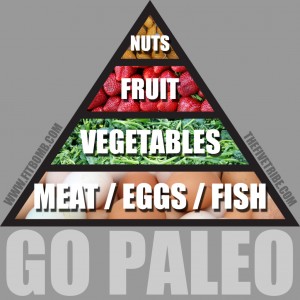In a nutshell, the Paleo Diet is modern man’s attempt to eat the way our Paleolithic ancestors ate. This means eating meats, vegetables, fruit and some nuts and seeds. In reality, the Paleo Diet is more than just a diet you use to achieve a specific goal, it’s a lifestyle that allows you to maximize your health and function at a high level of fitness.
Most of humanities’ evolution took place during the Paleolithic Era, which started about 2.5 million years ago. Through natural selection, our genes and physiology evolved around the foods that were available at that time: meats (including the fat and organs), fish, shellfish, eggs, vegetables, and limited quantities of fruits, nuts and seeds.
Unfortunately, we have strayed far away from that diet. With the advent of agriculture about 10,000 years ago our diet has transformed into one that is grain based. To put it in perspective, agriculture has only been around for .5% of man’s existance! Many of the foods that we consume today are foreign to our bodies’ physiology causing significant amounts of inflammation. This inflammation can lead to many of today’s leading health issues like obesity, cardiovascular disease, hyper-tension and autoimmune diseases, to name just a few.
Following a Paleo approach can restore a healthy metabolism and reduce inflammation in our bodies. Additionally it may boost energy level, improve body composition and enhance athletic performance
Rather than the grain based, low-fat diet recommended by many health care providers, take a look at the Paleo Pyramid:
This is the Paleo Diet in its simplest form. With the growing popularity of the Paleo Diet, there are many variations being offered. This can make things rather confusing for the Paleo neophyte. If you’re new to the world of Paleo, a great way to start is to follow a strict Paleo approach for 30 days. This means eliminating all dairy, grains, legumes, sugar and alcohol. This will give your body a chance to heal itself and reduce inflammation.
Following the 30 days, experiment a bit to see how your body reacts when you add in some “cheats”. Figuring out how you react to various foods will allow you to customize your intake based on your personal circumstances. Chris Kresser suggests using the term template rather than diet. “A Paleo template implies a more flexible and individualized approach. A template contains a basic format or set of general guidelines that can then be customized based on the unique needs and experience of each person.”
For instance, I have found that I can consume dairy, in limited amounts, with no adverse affects. I also allow myself an occasional adult beverage; a glass of wine or tequila. This fits into my lifestyle and doesn’t adversely affect me. Again, this is a personal decision and should involve some experimentation and personal reflection.
Following a template, rather than a strict “diet” will enable you to adapt this approach to your lifestyle, making it much more likely that you will stick with it and reap its many rewards.

